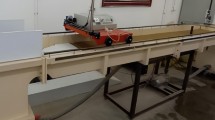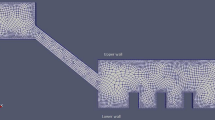Abstract
Dam-break flows are not only an important practical problem in civil and hydraulic engineering, but also a fundamental problem of fluid mechanics. Due to property damage and the loss of numerous lives, it is critically important to have an exhaustive understanding of the landslide dam-break flow and sedimentation. The main objective of this study is a detailed analysis of the mechanisms of dam-breaking flows through physical and theoretical modeling. Our experimental work was focused on the initial stages of dam-break flow in the water channel, where a thin plate separating water at different levels is impulsively withdrawn in the vertical direction upwards, and as a result, a hydrodynamic bore is formed. The theoretical model of the dam-break flow is based on Benney’s shallow water equations. We separately studied the regimes of a breaking and non-breaking bore front. On the hydrodynamic bore, the laws of conservation of mass, momentum, and energy were required in contrast to the classical solutions of Ritter and Stoker, in which the conservation of energy law was not considered at all. The non-breaking flow includes several zones: a shock wave and a shear vorticity flow after it, a contact surface and a continuous discharge zone. The bore in our solution moves faster than the classical bore, which, in turn, propagates faster than the contact surface. The breaking bore is characterized by the generation of a “mushroom-jet” structure, including a pair of vortices, oppositely directed, and a forerunner formed by the plunging jet directed forward. We found that the forerunner of the breaking bore has a speed significantly higher than the speed of the bore. The experiments carried out in the wave flume of the Tainan Hydraulics Laboratory confirmed the theoretical predictions of the proposed dam breaking flow model for various initial conditions.











Similar content being viewed by others
REFERENCES
A. Ritter, “Die Fortpflanzung de Wasserwellen,” Z. Ver. Dtsch. Ing.36 (33), 947–954 (1892).
J.J. Stoker, Water Waves (Interscience, New York, 1957).
T. Shigematsu, P. L.-F. Liu, and K. Oda, “Numerical modeling of the initial stages of dam-break waves,” J. Hydraul. Res.42 (2), 183–195 (2004). https://doi.org/10.1080/00221686.2004.9628303
T. M. Özgökmen, T. Iliescu, P. F. Fischer, A. Srinivasan, and J. Duan, “Large eddy simulation of stratified mixing in two-dimensional dam-break problem in a rectangular enclosed domain,” Ocean Model.16 (1-2), 106–140 (2007). https://doi.org/10.1016/j.ocemod.2006.08.006
A. Khayyer and H. Gotoh, “On particle-based simulation of a dam break over a wet bed,” J. Hydraul. Res.48 (2), 238–249 (2010). https://doi.org/10.1080/00221681003726361
A. Shakibaeinia and Y.-C. Jin, “A mesh-free particle model for simulation of mobile-bed dam break,” Adv. Water Resour.34 (6), 794–807 (2011). https://doi.org/10.1016/j.advwatres.2011.04.011
P. Z. Lin and P. L.-F. Liu, “A numerical study of breaking waves in the surf zone,” J. Fluid Mech. 359, 239–264 (1998). https://doi.org/10.1017/S002211209700846X
P. Lin and P. L.-F. Liu, “Turbulence transport, vorticity dynamics, and solute mixing under plunging breaking waves in surf zone,” J. Geophys. Res. 103 (C8), 15677–15694 (1998). https://doi.org/10.1029/98JC01360
P. Lin and W. Xu, “NEWFLUME: A numerical water flume for two-dimensional turbulent free surface flows,” J. Hydraul. Res. 44 (1), 79–93 (2006). https://doi.org/10.1080/00221686.2006.9521663
H.-C. Hsu, A. Torres-Freyermuth, T.-J. Hsu, H.‑H. Hwung, and P.-C. Kuo, “On dam-break wave propagation and its implication to sediment erosion,” J. Hydraul. Res.52 (2), 205–218 (2014). https://doi.org/10.1080/00221686.2013.857365
U.S. Army Corps of Engineers, “Floods resulting from suddenly breached dams,” Misc. Paper 2–374, Report 1, Waterways Experiment Station (1960).
G. Lauber and W. H. Hager, “Experiments to dambreak wave: Horizontal channel,” J. Hydraul. Res. 36 (3), 291–307 (1998). https://doi.org/10.1080/00221689809498620
P. K. Stansby, A. Chegini, and T. C. D. Barnes, “The initial stages of dam-break flow,” J. Fluid Mech.374, 407–424 (1998). https://doi.org/10.1017/S0022112098001918
S. Briechle and J. Kötenger, “Experimental data for dike-break waves,” in Proceedings of the International Conference on Fluvial Hydraulics “River Flow 2002”, Ed. by D. Bousmar and Y. Zech (Balkema, Rotterdam, The Netherlands, 2002), pp. 467–473.
J. G. A. B. Leal, R. M. L. Ferreira, and A. H. Cardoso, “Dam-break waves on movable bed,” in Proceedings of the International Conference on Fluvial Hydraulics “River Flow 2002”, Ed. by D. Bousmar and Y. Zech (Balkema, Rotterdam, The Netherlands, 2002), pp. 981–990.
H. Capart, and D. L. Young, “Formation of a jump by the dam-break wave over a granular bed,” J. Fluid Mech. 372, 165–187 (1998). https://doi.org/10.1017/S0022112098002250
A. A. Khan, P. M. Steffler, and R. Gerard, “Dam-break surges with floating debris,” J. Hydraul. Eng. 126 (5), 375 (2000). https://doi.org/10.1061/(ASCE)0733-9429(2000)126:5(375)
A. J. Crespo, M. Gómez-Gesteira, and R. A. Dalrymple, “Modeling dam break behavior over a wet bed by a SPH technique,” J. Waterw., Port, Coastal, Ocean Eng.134 (6), 313 (2008). https://doi.org/10.1061/(ASCE)0733-950X(2008)134:6(313)
I. M. Jánosi, D. Jan, K. G. Szabó, and T. Tél, “Turbulent drag reduction in dam-break flows,” Exp. Fluids. 37 (2), 219–229 (2004). https://doi.org/10.1007/s00348-004-0804-4
H. Chanson, S. I. Aoki, and M. Maruyama, “An experimental study of tsunami runup on dry and wet horizontal coastlines,” Sci. Tsunami Hazards.20 (5), 278–293 (2003).
D. R. Lebedev and Yu. I. Manin, “The Benny equations of long waves II. The Lax representation and the conservation laws,” J. Sov. Math. 21 (5), 769–776 (1983). http://www.mathnet.ru/php/archive.phtml?wshow= paper&jrnid=znsl&paperid=3246&option_lang=eng
Funding
The reported study was funded by RFBR and TUBITAK according to the research project no. 20-55-46005. The authors acknowledge the financial support from the Ministry of Science and Technology of Taiwan under Grant Number MOST 106-2221-E-110-036-MY3 for this study. This research was also performed in the framework of the state assignment of FASO Russia (Theme no. 0149-2018-0015).
Author information
Authors and Affiliations
Corresponding author
Additional information
The text was submitted by the authors in English.
About this article
Cite this article
Shugan, I.V., Chen, YY. & Hsu, CJ. Experimental and Theoretical Study on Flood Bore Propagation and Forerunner Generation in Dam-Break Flow. Phys. Wave Phen. 28, 274–284 (2020). https://doi.org/10.3103/S1541308X20030188
Received:
Revised:
Accepted:
Published:
Issue Date:
DOI: https://doi.org/10.3103/S1541308X20030188




